This pub takes its name from its location at the end of Leith Walk, originally laid out as a pedestrian route to and from Edinburgh. Edinburgh’s outlet to the sea for centuries, Leith remained an independent burgh until 1920.
Prints and text about The Foot of the Walk.
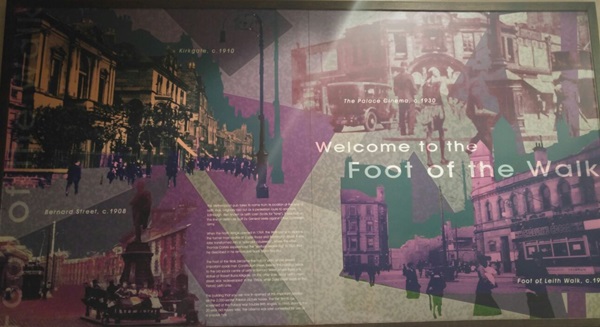
The text reads: This Wetherspoon pub takes its name from the location at the end of Leith Walk, originally laid out as a pedestrian route to and from Edinburgh. Also known as Leith Loan (Scots for ‘lane’), it was built on the line of defences built by general Leslie against Oliver Cromwell’s army.
When the North Bridge opened in 1769, the walk came to replace the former main routes of Easter Road and Bonnington Road. It was later transformed into a splendid causeway, where the writer Thomas Carlyle experienced the “spiritual awakening” in 1821 that he described in his remarkable book Sartor Resartus.
The Foot of the Walk became the hub of Leith, where several important roads met. Constitution Street, besides this building, leads to the old social centre in Leith in Bernard Street, where there is a statue of Robert Burns. Kirkgate, on the other side, once Leith’s main street, was redeveloped in the 1960s, whilst Duke Street leads to the historic Leith links.
The building that you are now in opened at the important junction as the 2,000 seater Palace picture house. The last film to be screened at the Palace was Trouble with Angels, in 1966, starring the 20 year old Hayley Mills. The cinema was later converted for use as a snooker hall.
Prints and text about royal connections.
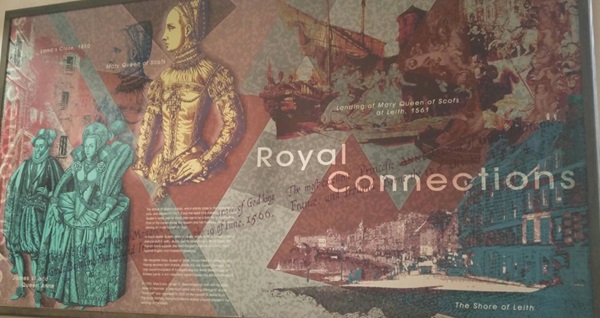
The text reads: The statue of Queen Victoria, which stands close to this Wetherspoon pub, was erected in 1907. It was the result of a meeting in the nearby Queen’s Hotel, part of which later became a branch of Woolworth’s. One of the panels shows the Queen and her husband, Prince Albert, arriving on a visit to Leith in 1842.
A much earlier Queen, Mary of Guise, widow of King James V, had a palace built in Leith, usually said to have stood in Water Street. With French naval support, she held the port for seven months in 1560, against English and Protestant besiegers.
Her daughter, Mary Queen of Scots, landed here the following year, having returned from France, where she was Queen Dowager. The only accommodation fit for royalty was the Water Street House of Andrew Lamb, a rich merchant. Lamb’s House has since been rebuilt.
In 1590, Mary’s son, James VI, disembarked at Leith with his bride, Anne of Denmark. A later royal arrival was King George IV, whose state visit was organised in 1822 by the novelist Sir Walter Scott. The King’s startling Highland costume revived popular interest in the wearing of the tartan.
Photographs and text about Robert Louis Stevenson.
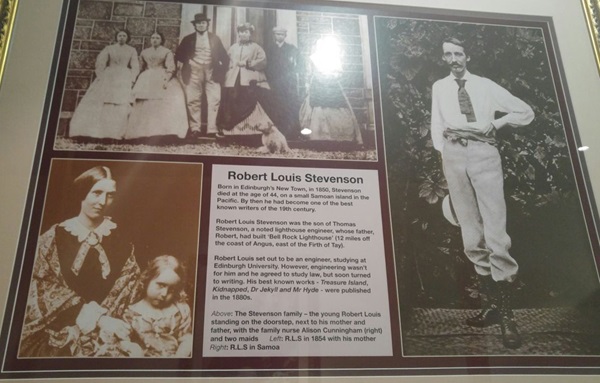
The text reads: Born in Edinburgh’s New Town, in 1850, Stevenson died at the age of 44, on a small Samoan island in the Pacific. By then he had become one of the best known writers of the 19th century.
Robert Louis Stevenson was the son of Thomas Stevenson, a noted lighthouse engineer, whose father, Robert, had built Bell Rock Lighthouse (12 miles off the coat of Angus, east of the Firth of Tay).
Robert Louis set out to be an engineer, studying at Edinburgh University. However, engineering wasn’t for him and he agreed to study law, but soon turned to writing. His best known works – Treasure Island, Kidnapped, Dr Jekyll and Mr Hyde – were published in the 1880s.
Above: The Stevenson family – the young Robert Louis standing on the doorstep, next to his mother and father, with the family nurse Alison Cunningham (right) and two minds
Left: RLS in 1854 with his mother
Right: RLS in Samoa.
Prints and text about ships and ship-building in the area.
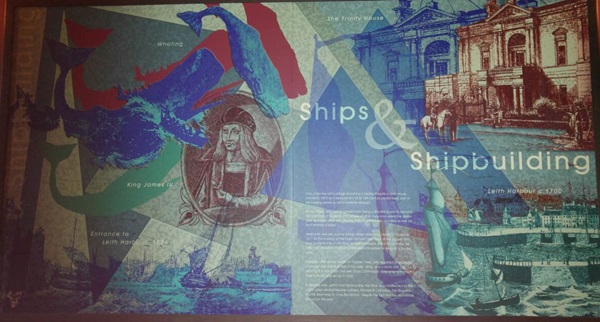
The text reads: One of the few old buildings remaining in nearby Kirkgate is Trinity House. Erected in 1816 as a replacement for its 16th century predecessor, part of the building serves as Leith’s Maritime Museum.
By the 1500s, Leith had progressed from being a tiny fishing port to become the chief port of Scotland, from where whaling ships once sailed the distant seas. Its traders dealt with cargoes from Mediterranean countries as well as from northern Europe.
Newhaven was also a small fishing village when King James IV chose it in 1511 for the building of the Great Michael, described as the biggest and most powerful ship of the time. He built dockyards at the Novus Portus de Leith, and imported continental shipwrights to realise his vision of a Scottish navy.
However, after James’ death on Flodden Field, Leith regained its superiority. A wooden pier was built here in the early 1600s, and a stone one, with a dock by it, in the 1720s. The Leith Dock Commission, forerunner of the Forth Ports Authority, was set up in 1826.
A decade later, Leith’s most famous ship, the Sirius, was constructed by the port’s oldest established ship-builders, Menzies & Company. The Sirius was the first steamship to cross the Atlantic, despite the fact that her coal-stocks ran out of the way!
Prints and text about historical sporting events.
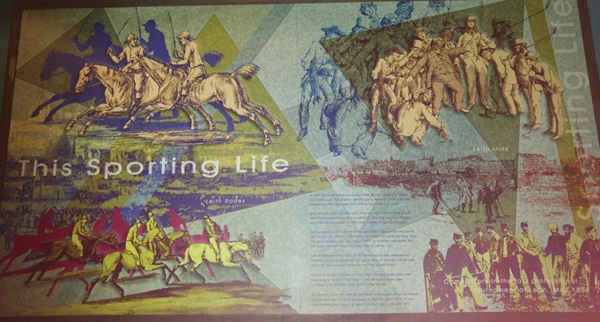
The text reads: In 1457, the Scots’ Parliament ordered that golf be “utterly cryt downe and nocht usyt”. The problem with the game was that it was popularly preferred to the more useful and patriotic practice of archery.
Both were practiced on Leith Links. However, official disapproval of golf had disappeared by the time of James VI. The King was an enthusiast and both his sons played at Leith whilst staying at Holyrood Palace.
The Honourable Company of Edinburgh Golfers drew up the first rules of golf for the Leith Links in 1744, but by 1833 they had gone bankrupt. They moved to Musselburgh, and then, in 1891, to Murifield. Meanwhile the first Open Championship had been held at Leith in 1860.
Leith Races were once held on The Sands before they disappeared beneath the dock extensions. The Sands were an extension of the Links, and both were used for recreation from the earliest times.
Formal races, first recorded in 1661, seem to have started from the exercising of horses of the beach. Four years later, riders were competing for the King’s Cup on a 12 mile course.
By the end of the 18th century, the race meeting had become a week long annual event. The races moved to Musselburgh in 1816. A new race meeting was begun 20 years later, but lasted only until 1859.
External photograph of the building – main entrance.
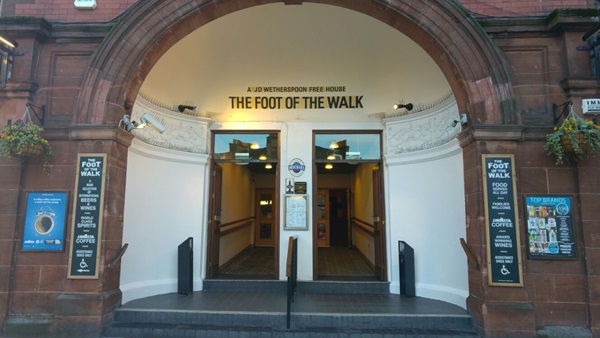
If you have information on the history of this pub, then we’d like you to share it with us. Please e-mail all information to: pubhistories@jdwetherspoon.co.uk